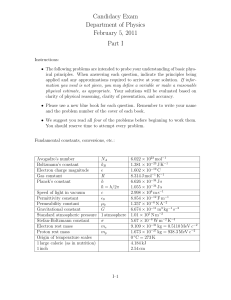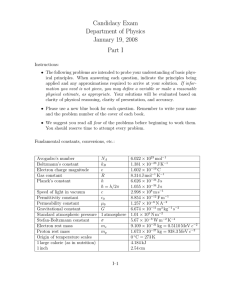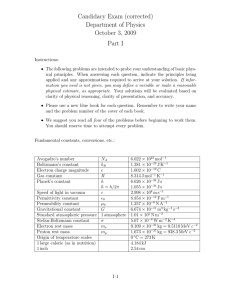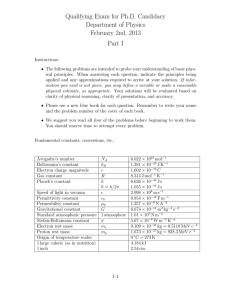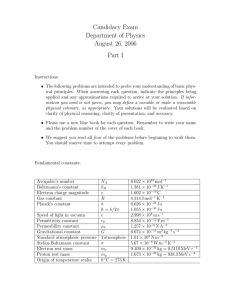Qualifying Exam for Ph.D. Candidacy Department of Physics October 17th, 2015 Part I
advertisement
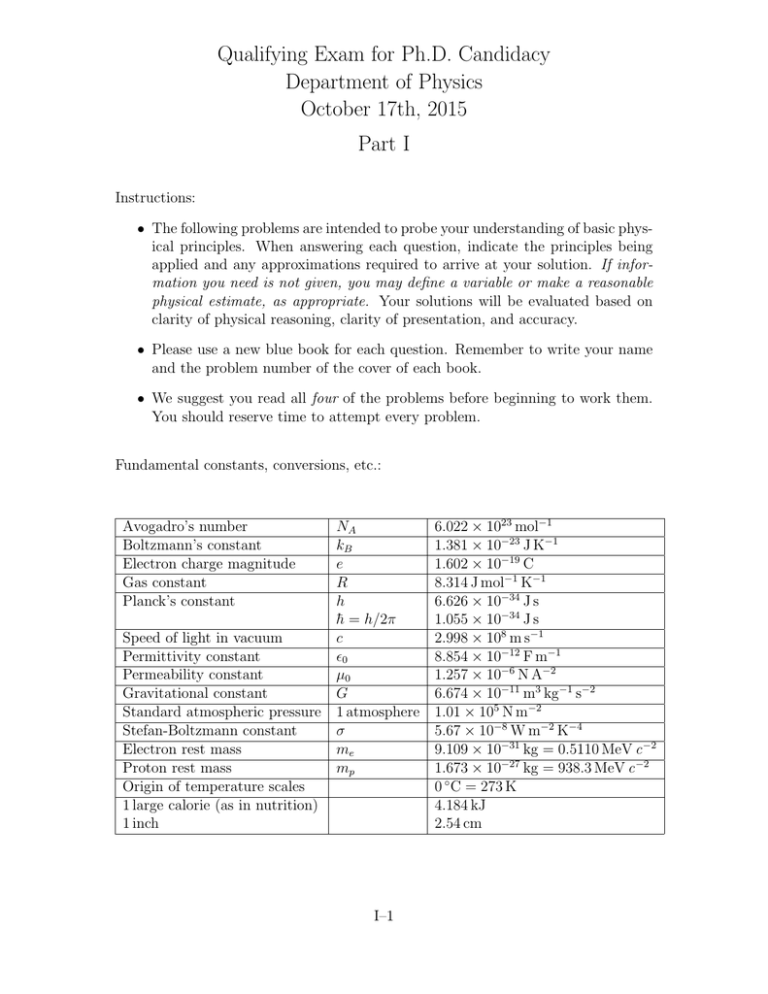
Qualifying Exam for Ph.D. Candidacy Department of Physics October 17th, 2015 Part I Instructions: • The following problems are intended to probe your understanding of basic physical principles. When answering each question, indicate the principles being applied and any approximations required to arrive at your solution. If information you need is not given, you may define a variable or make a reasonable physical estimate, as appropriate. Your solutions will be evaluated based on clarity of physical reasoning, clarity of presentation, and accuracy. • Please use a new blue book for each question. Remember to write your name and the problem number of the cover of each book. • We suggest you read all four of the problems before beginning to work them. You should reserve time to attempt every problem. Fundamental constants, conversions, etc.: Avogadro’s number Boltzmann’s constant Electron charge magnitude Gas constant Planck’s constant NA kB e R h h̄ = h/2π Speed of light in vacuum c Permittivity constant 0 Permeability constant µ0 Gravitational constant G Standard atmospheric pressure 1 atmosphere Stefan-Boltzmann constant σ Electron rest mass me Proton rest mass mp Origin of temperature scales 1 large calorie (as in nutrition) 1 inch I–1 6.022 × 1023 mol−1 1.381 × 10−23 J K−1 1.602 × 10−19 C 8.314 J mol−1 K−1 6.626 × 10−34 J s 1.055 × 10−34 J s 2.998 × 108 m s−1 8.854 × 10−12 F m−1 1.257 × 10−6 N A−2 6.674 × 10−11 m3 kg−1 s−2 1.01 × 105 N m−2 5.67 × 10−8 W m−2 K−4 9.109 × 10−31 kg = 0.5110 MeV c −2 1.673 × 10−27 kg = 938.3 MeV c −2 0 ◦ C = 273 K 4.184 kJ 2.54 cm Definite integrals: Z ∞ −x2 e Z 0 ∞ √ π dx = . 2 (I–1) xn e−x dx = Γ(n + 1) = n!. (I–2) 0 I–1. A crude approximation of the CO2 molecule by a classical system is depicted in the figure. It consists of masses m1 = 16 and m2 = 12 (in some units) connected by identical springs as in the figure below; their motion is one-dimensional. (i) Determine the ratio between the frequencies of the normal vibrational modes. (ii) Describe the motion of the carbon and oxygen atoms in each vibrational mode. m1 k m2 k m1 I–2. A particle of mass m moving in one dimension is confined to the region 0 < x < L of zero potential energy by an infinite well potential. In addition, the particle experiences a delta function potential V (x) = λδ(x − L ), 2 where λ is a positive real parameter. Find the equations for the energy eigenvalues E of the particle in terms of the mass m, and the parameters λ and L. I–3. An ideal monoatomic gas is enclosed in a cylinder of radius a and length L. The cylinder rotates with angular velocity ω about its symmetry axis and the ideal gas is in equilibrium at temperature T in the coordinate system rotating with the cylinder. Assume that the atoms of gas obey classical statistics, each of them has mass m and has no internal degrees of freedom. (i) What is the Hamiltonian in the rotating coordinate system? (ii) What is the partition function for the system? (iii) What is the average number density as a function of r, the distance from the rotation axis? I–2 I–4. Two very long concentric conducting cylindrical shells are located at radius r1 and r2 from an axis. The length of the cylinders is L . Between the cylinders is a medium with dielectric constant κ = ε/ε0 . Determine the polarization field in the dielectric medium if the electric potential difference between inner and outer cylinders is V0 . Determine the expression for the free charge on the inner conductor. I–3 Qualifying Exam for Ph.D. Candidacy Department of Physics October 17th, 2015 Part II Instructions: • The following problems are intended to probe your understanding of basic physical principles. When answering each question, indicate the principles being applied and any approximations required to arrive at your solution. If information you need is not given, you may define a variable or make a reasonable physical estimate, as appropriate. Your solutions will be evaluated based on clarity of physical reasoning, clarity of presentation, and accuracy. • Please use a new blue book for each question. Remember to write your name and the problem number of the cover of each book. • We suggest you read all four of the problems before beginning to work them. You should reserve time to attempt every problem. Fundamental constants, conversions, etc.: Avogadro’s number Boltzmann’s constant Electron charge magnitude Gas constant Planck’s constant NA kB e R h h̄ = h/2π Speed of light in vacuum c Permittivity constant 0 Permeability constant µ0 Gravitational constant G Standard atmospheric pressure 1 atmosphere Stefan-Boltzmann constant σ Electron rest mass me Proton rest mass mp Origin of temperature scales 1 large calorie (as in nutrition) 1 inch II–1 6.022 × 1023 mol−1 1.381 × 10−23 J K−1 1.602 × 10−19 C 8.314 J mol−1 K−1 6.626 × 10−34 J s 1.055 × 10−34 J s 2.998 × 108 m s−1 8.854 × 10−12 F m−1 1.257 × 10−6 N A−2 6.674 × 10−11 m3 kg−1 s−2 1.01 × 105 N m−2 5.67 × 10−8 W m−2 K−4 9.109 × 10−31 kg = 0.5110 MeV c −2 1.673 × 10−27 kg = 938.3 MeV c −2 0 ◦ C = 273 K 4.184 kJ 2.54 cm Definite integrals: Z ∞ −x2 e 0 ∞ Z √ π dx = . 2 (II–1) xn e−x dx = Γ(n + 1) = n!. (II–2) 0 II–1. A rocket car releases the combustion gas at a speed v with respect to itself and the mass of the combustion gas released per unit time is µ. Assume that the car is initially at rest. (i) What is the speed of the car after its mass (the joint mass of the structure of the car and the fuel) has decreased n times. (ii) What is the minimal time required for a car whose structure mass is m to reach the speed of sound vs . II–2. (i) Consider a simple one-dimensional quantum mechanical harmonic oscillator of mass m and frequency ω. Starting from the Hamiltonian operator H0 in terms of the coordinate and momentum operators x and p, H0 = P2 + V0 2m with V0 = mω 2 x2 , 2 express it in terms of creation and annihilation operators. Find its normalized eigenvectors in terms of creation operators and the eigenvalues. (ii) The anharmonic term V1 (x) = Kx4 is added to the Hamiltonian H0 . Assuming that V1 is a small perturbation, calculate the first order correction to the energy levels (i.e. the expectation values hψn |V1 (x)|ψn i where |ψn i are the eigenstates of H0 ). II–3. (i) Find the efficiency of a reversible engine operating around the cycle in figure II–1(a). T is the temperature in K and S is the entropy in Joules/K. (ii) What is the efficiently of the reversible engine operating around the cycle in figure II–1(b)? Is it larger or smaller than the efficiency of an engine operating around the cycle in figure II–1(a)? II–4. Consider the two circuits shown in the figure II–2. Circuit #1 is a toroidal coil with an inner radius a, an outer radius b, a height c, and wound with N total turns. The toroid is coaxial with one segment of a flat rectangular circuit loop II–2 T T 400 400 300 300 500 1000 S 500 (a) 1000 S (b) Figure II–1: Thermodynamic cycles (circuit #2) which lies along the z-axis. The rectangular loop has a height h and a width w. The figure to the right of fig. II–2 shows a cross sectional view in the plane of the rectangular circuit (circuit #2). (i) Find the mutual inductance M between the two circuits. (ii) If a time-varying current I2 = kt, flows in the rectangular loop, what is the electro-motive force (EMF) induced in the toroid? Figure II–2: Circuits II–3
